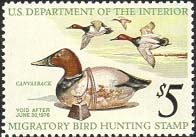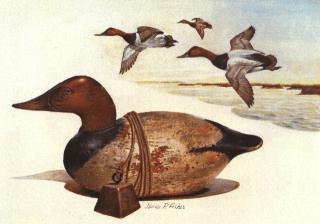

Back to RW42 Back to the Federal Index Home
A LITTLE HISTORY ON THE 42ND (1975-76) DUCK STAMP ARTIST


It seems that Jim Fisher was more truant than student in his early school years. Instead of completing his assignments, he was often preoccupied with drawing animals and birds, or sketching his classmates. Armed with pencil, paper, and public library books about natural history, he would play hooky and roam the Brandywine Valley. His interest in wildlife art began to take form.
He attended the Wilmington Academy of Art, taking on his first full-time job to pay his tuition and purchase art supplies. Some of his teachers were nationally known artists including Gayle P. Hoskins, Frank E. Schoonover, and N.C. Wyeth.
Mr. Fisher spent only three years at the Academy before the depression of the thirties arrived in full force. He realized that, "If I am to eat, I had better transform my talents into some saleable form." He turned to theater lobby art, taught by M. Hayes, a Bostonian. He earned his living making full-sheet posters that featured a portrait of the star and listed the usual credits for the supporting cast, director, producer, etc. Handcrafted posters became a lost art form, however, with the advent of the silk-screen process.
He married Irene Green, a registered nurse, when he was 27, and subsequently moved to a small farm in Chester County, Pennsylvania. Commercial advertising are continued to take up most of his time, but he had the opportunity to pursue his lifelong interest in wildlife in the Pennsylvania countryside, which teemed with native birds and animals. Their only son, Jim, Jr., was born in 1950. Quite conveniently for his father, he became a professional photographer whose skills came in quite handy when doing research for a painting.
Mr. Fisher had a fascination with old derelict decoys, and went to a decoy show in Elkton, Maryland in 1973. It was there that he met Mr. R.G. Biddle III, a collector who offered to let him borrow decoys from his collection for painting. A weathered old Mason Canvasback drake attracted Mr. Fisher in particular, and he decided to paint it for his first and only entry in the annual Duck Stamp contest.
Mr. Fisher passed away.
--------------------THE ART--------------------
Canvasback Decoy was painted in full-color watercolor. The print is a combination of collotype and offset lithography printed in seven colors on 100 percent rag content Arches 88 paper. The edition of 3,150 prints and 150 artist's proofs are hand signed in pencil and numbered. Some prints are remarqued. The image size of the print is 6-1/2" x 9". This is the one and only design that will feature a decoy on a Federal Duck Stamp. A rules change now only allows live species to be represented.
--------------------THE STAMP--------------------
Canvasback Decoy…Engraved by the Federal Bureau of Engraving from the original artwork. Printed in yellow, orange, green, grey, brown, and black ink. Stamp sold for five dollars. Postal records show 2,218,589 stamps sold. First day of sale was July 1, 1975..
Most of the information contained above is from the book Federal Duck Stamp Story, Fifty Years of Excellence, by Laurence F. Jonson; Alexander & Co. It is used here with permission from the author. For more information on this book, please click here.